Pesticide Usage in Scotland: Grassland and Fodder Crops 2017
This publication presents information from a survey of pesticide use on grassland and fodder crops in Scotland during 2017.
This document is part of a collection
General trends
Crop area – grassland and rough grazing
The estimated area of grassland and rough grazing in 2017 was 4,363,985 hectares ( Table 16). This is very similar to the area recorded in 2013 (3) and a six per cent decrease from 2009 (4) . Since the last survey, the area of rough grazing has remained almost the same, grass over five years old has increased by 26 per cent and grass under five years old and undersown grass have decreased by 53 per cent and 51 per cent respectively (Figure 1). However, it should be noted that these changes in reported crop areas, and the subsequent estimates of pesticide use made using these census areas, may have been influenced by changes in the census definitions of temporary and permanent grass implemented since the last survey rather than wholly reflecting changes in land use (refer to Appendix 4).
In 2017, rough grazing accounted for 70 per cent of Scottish grassland area, grass over five years old 25 per cent and grass under 5 years old five per cent. Undersown grass accounted for less than 0.5 per cent of the crop (Figure 2). Over half of all grassland and rough grazing in Scotland is in the Highlands and Islands region (Figure 3).
Figure 1: Area of grassland and rough grazing in Scotland 2009-2017
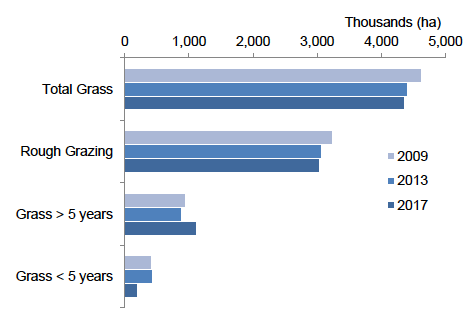
Note: Undersown grass has been excluded as the area grown is <30,000 hectares.
There was a change in census definition of temporary and permanent grass between 2013 and 2017. Therefore reported crop changes may not wholly reflect changes in land use ( Appendix 4)
Figure 2: Grassland and rough grazing census areas in Scotland 2017 (percentage of total area)
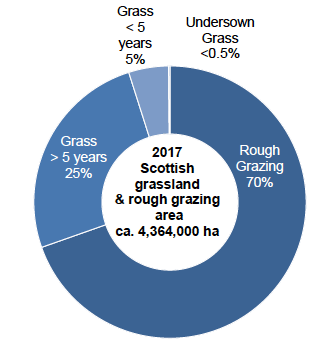
Figure 3: Regional distribution of grassland and rough grazing in Scotland 2017 (percentage of total area)
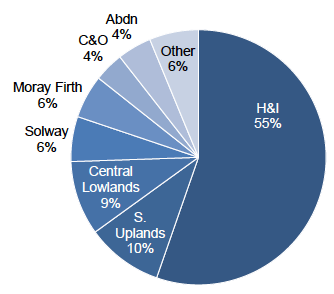
Note: H&I = Highlands and Islands, S. Uplands = Southern Uplands, C&O = Caithness and Orkney, Abdn = Aberdeen, Other = Angus, East Fife, Lothian and Tweed Valley
Crop area – fodder crops
The estimated area of fodder crops grown in 2017 was 16,304 hectares ( Table 17). This represents a 16 per cent decrease from 2013 and a 29 per cent decrease from 2009. Since the previous survey, the areas of maize, other stock-feeding crops, turnips & swedes and fodder rape have decreased in area (44, 25, 7, 5 per cent respectively). In contrast, areas of fodder beet and kale & cabbage have increased (32 and six per cent respectively, Figure 4).
In 2017, almost half of the fodder crops were found in the ‘other stock-feeding’ category of the census (Figure 5). Within this category, 85 per cent of the crops were arable silage. Turnips & swedes, fodder rape and kale & cabbage were also widely grown (23, 12 and 12 per cent of the total fodder crop area respectively). Fodder crops are fairly evenly distributed within Scotland, with the largest proportion, 21 per cent, grown in the Aberdeen region (Figure 6).
Figure 4: Area of fodder crops in Scotland 2009-2017
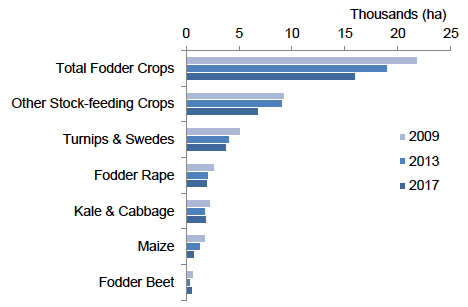
Note: ‘other stock-feeding crops’ include arable silage, red clover, swedes, kale, stubble turnips and fodder crop mixes
Figure 5: Fodder crop census areas Scotland 2017 (percentage of total area)
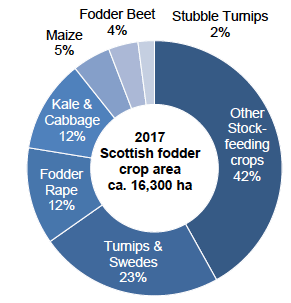
Note: ‘other stock-feeding crops’ include arable silage, red clover, swedes, kale, stubble turnips and fodder crop mixes
Figure 6: Regional distribution of fodder crops in Scotland 2017 (percentage of total area)
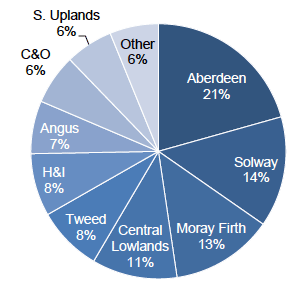
Note: H&I = Highlands and Islands, C&O = Caithness and Orkney, S. Uplands = Southern Uplands, Other = Lothian and East Fife
Pesticide usage – grassland and rough grazing
As in previous surveys, the proportion of grassland and rough grazing treated with a pesticide was very low. Only four per cent of grassland and less than 0.5 per cent of rough grazing was treated with a pesticide and these areas received, on average, a single spray during 2017 ( Table 1).
It is estimated that the area of grassland and rough grazing treated with a pesticide formulation in 2017 was ca. 87,900 hectares ( Table 16 & Figure 7). This represents an increase of one per cent since 2013 but a decrease of 38 per cent from 2009. A similar pattern is shown in relation to the weight of pesticide applied; 84 tonnes was applied in 2017, a decrease of two per cent from 2013 and a decrease of 33 per cent from 2009 (Figure 8).
Figure 7: Area of grassland and rough grazing treated with the major pesticide groups in Scotland in 2009-2017
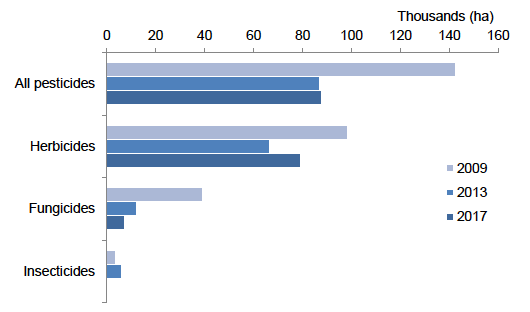
Note: Seed treatments, growth regulators, sulphur and molluscicides have been excluded as they represent <1,000 hectares
Figure 8: Weight of major pesticide groups applied to grass crops in Scotland 2009-2017
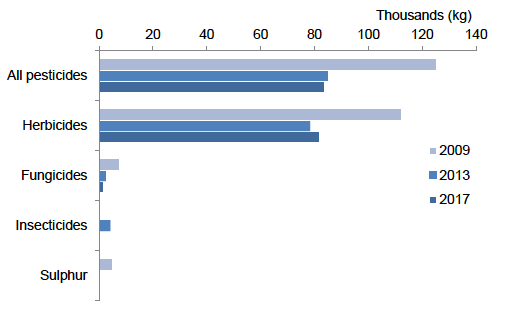
Note: Seed treatments, growth regulators and molluscicides have been excluded as they represent <1,000 kg
In order to make accurate comparisons between surveys, temporal differences in crop area must be taken into account. Therefore, the number of pesticide treated hectares and total weight of pesticide used per hectare of crop grown have been calculated. Once pesticide use has been adjusted for crop area, there is little difference in pesticide treated area or weight on grassland and rough grazing between 2013 and 2017 (Figures 9 and 10). However, there is a substantial reduction in pesticide use in comparison to 2009 (34 per cent decrease in treated area and 28 per cent decrease in weight).
As noted in the trends in crop area section of the report, the census grass area and, as a result, subsequent estimates of pesticide use, may have been influenced by changes in census definitions of temporary and permanent grass implemented since the last survey rather than wholly reflecting changes in land use (refer to Appendix 4).
Figure 9: Number of pesticide treated hectares (formulations) per hectare of grass crop grown - 2017
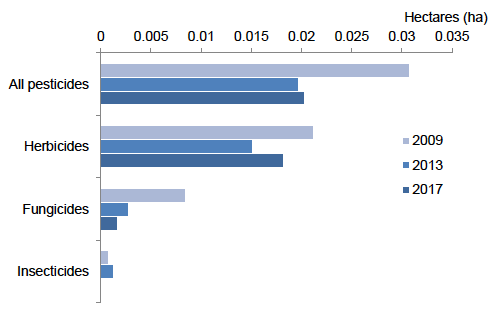
Figure 10: Weight of pesticides applied per hectare of grass crop grown – 2017
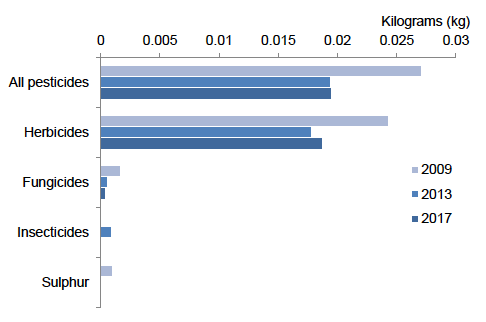
Note: Seed treatments, growth regulators and molluscicides have been excluded as they represent <0.001 kg per hectare
Despite overall pesticide use being very similar to that reported in the last survey, there were some differences in the types of pesticides encountered. As in previous surveys, herbicides were the most commonly used pesticides on grassland and rough grazing in 2017, accounting for 90 per cent of the treated area and 98 per cent of total pesticide use by weight (Figures 11 & 12). The majority of herbicide use was on undersown and direct sown grass (60 per cent and 20 per cent of crop area treated respectively). Herbicides were the only type of pesticide applied to one to four year old grass, grass over five years old and rough grazing ( Table 1). When changes in crop area are taken into account, there was there was a 20 per cent increase in the area treated with herbicides from 2013 to 2017 (Figure 9) and a five per cent increase in herbicide weight (Figure 10). Mean Scottish winter and spring temperatures in 2017 were 78 and 57 per cent higher respectively than in 2013. These warmer conditions may have increased weed pressure and could have contributed to this increase in reported herbicide use (5) .
Figure 11: Use of pesticides on grassland and rough grazing (percentage of total area treated with formulations) - 2017
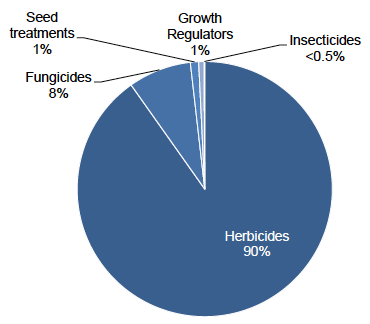
Figure 12: Use of pesticides on grassland and rough grazing (percentage of total weight of pesticides applied) – 2017
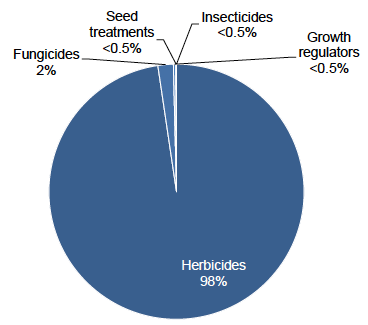
In 2017, fungicides accounted for eight per cent of the total pesticide treated area and less than two per cent of the total weight applied (Figures 11 & 12). Fungicides were only applied to undersown grass for the control or prevention of disease on the nurse crop. Forty eight per cent of undersown grass was treated, with an average of 1.3 fungicide applications. When changes in crop area are taken into account, the fungicide treated area decreased by 41 per cent from 2013 to 2017 (Figure 9) and the weight applied decreased by 33 per cent (Figure 10). Again, this may have been influenced by differences in the weather in the two crop seasons. Winter and spring 2017 had 12 and 15 per cent less rainfall respectively than in 2013 as well as fewer rain days. This may have reduced disease pressure and the requirement for fungicide sprays (5) .
Growth regulators accounted for only one per cent of the total pesticide treated area and less than 0.5 per cent of the total weight of pesticides applied (Figures 11 & 12). Growth regulators were only applied to undersown grass, of which eight per cent of the crop area was treated. When changes in crop area are taken into account, there was a 15 per cent decrease in area treated between 2013 and 2017 (Figure 9) and a seven per cent decrease in weight applied (Figure 10).
Seed treatments also accounted for only one per cent of the total pesticide treated area and less than 0.5 per cent of the total weight of pesticides applied. (Figures 11 & 12). Seed treatments were only applied to direct sown grass, of which five per cent of the crop area received a treatment. When changes in crop area are taken into account, there was a 37 per cent decrease in area treated between 2013 and 2017 (Figure 9). However, the weight of seed treatments applied increased by 58 per cent (Figure 10). This reduction in treated area but increased pesticide weight in 2017 is a result of recording seed treatments applied at different dose rates in the two surveys. In 2013 both Bacillus subtilis, a biological seed treatment applied at very low dose rates, and thiram were encountered, in 2017 thiram was the only seed treatment recorded.
There was a substantial decrease in the use of insecticides on grass crops in 2017 (Figures 7 & 8). Insecticides accounted for less than 0.5 per cent of the total pesticide treated area and weight applied (Figures 11 & 12). Insecticide use was only recorded, on one per cent of undersown grass, for insect control on the nurse crop. When changes in crop area are taken into account, treated area decreased by 99 per cent between 2013 and 2017 (Figure 9) and weight of insecticides decreased by >99 per cent (Figure 10). In 2016, the active substance chloropyrifos, which was used as a treatment for leatherjackets on grass in the previous survey, was withdrawn. As there are no alternative pesticides approved for leatherjacket control, insecticide use on grass crops was not encountered in this survey. However, some farmers reported that they used non-chemical methods for control of leatherjackets (see Appendix 6).
No molluscicides or sulphur were applied to grassland or rough grazing crops in 2017. In the 2013 survey, molluscicides accounted for less than one per cent of the total pesticide treated area and use of sulphur was not encountered (last recorded in 2009).
Pesticide usage – fodder crops
In contrast to pesticide use on grassland, an estimated 63 per cent of the total fodder crop was treated with a pesticide ( Table 1). The area of fodder crops treated with a pesticide formulation in 2017 was estimated to be ca. 24,300 hectares ( Table 17 & Figure 13) and the total weight of pesticide applied ca. eight tonnes (Figure 14). When crop area is taken into account, there was a decrease of 31 per cent in total area treated with pesticide formulations from 2013 to 2017 and a 21 per cent decrease from 2009 to 2017 (Figure 15). In terms of weight of pesticide applied, there was a 34 per cent decrease from 2013 to 2017 and a 38 per cent decrease from 2009 to 2017 (Figure 16).
Maize and fodder beet crops had the highest proportion of area treated, with all crops encountered receiving at least one pesticide treatment ( Table 1). Other fodder crops received a range of pesticide input, with 29 to 58 per cent of their crop area treated with pesticide, primarily herbicide. In contrast, no pesticide treatments were recorded on stubble turnips.
Figure 13: Area of fodder crops treated with the major pesticide groups in Scotland in 2009–2017
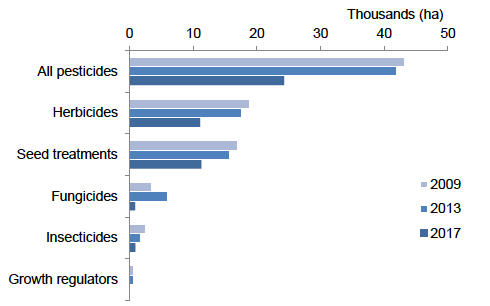
Note: molluscicides and sulphur have been excluded as they represent less than 500 hectares
Figure 14: Weight of major pesticide groups applied to fodder crops in Scotland 2009-2017
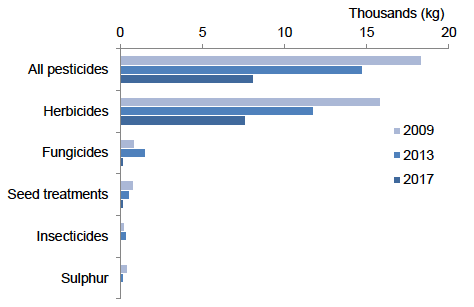
Note: growth regulators and molluscicides have been excluded as they represent <400kg
Figure 15: Number of pesticide treated hectares (formulations) per hectare of fodder crop grown - 2017
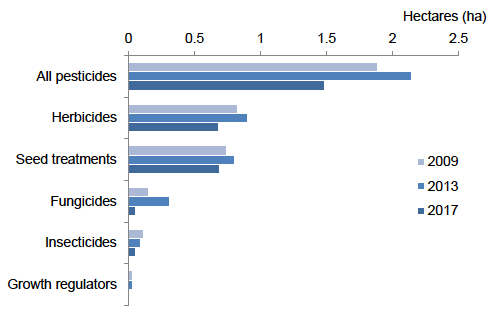
Note: molluscicides and sulphur have been excluded as they represent less than 0.02 treated hectares per hectare grown
Figure 16: Weight of pesticides applied per hectare of fodder crop grown - 2017
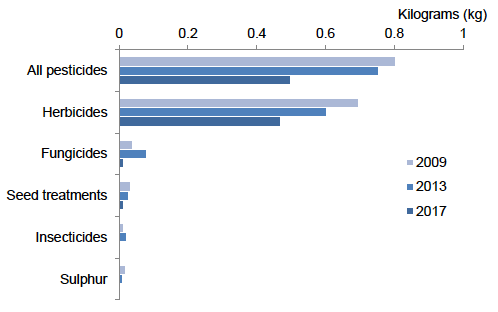
Note: growth regulators and molluscicides have been excluded as they represent <1,000kg
Herbicides were the most commonly used pesticide, accounting for 46 per cent of the area treated (Figure 17) and 94 per cent of the total weight of pesticides applied (Figure 18). When changes in crop area were taken into account, there was a 25 per cent decrease in area treated with herbicides from 2013 to 2017 (Figure 15) and a 22 per cent decrease in weight (Figure 16). This reduction is in contrast to the increase in herbicide use encountered in grass crops and may have been influenced by the limited number of post emergence herbicide options currently available for use on fodder brassicas (6) . The dry spring may also have reduced the likelihood of secondary weed germination flushes (F. Burnett, SRUC, pers. comm. Aug 2018). In addition, changes in crop specific cultivation methods, such as increased use of plastic film on maize crops at establishment, may also have influenced changes in herbicide use.
Figure 17: Use of pesticides on fodder crops (percentage of total area treated with formulations) - 2017
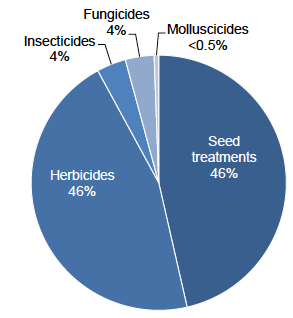
Figure 18: Use of pesticides on fodder crops (percentage of total weight applied) – 2017
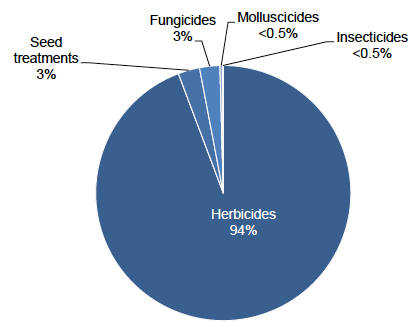
Seed treatments accounted for 46 per cent of the total area treated and three per cent of the total weight of pesticide applied (Figures 17 & 18). When changes in crop area were taken into account, the area treated decreased by 14 per cent from 2013 to 2017 (Figure 15) and weight decreased by 52 per cent (Figure 16). There are no clear reasons for this reduction in seed treatments, influencing factors may be the smaller range of approved seed treatments available in comparison with the last survey and differences in the areas of the types of fodder crops grown.
Fungicide use was low in fodder crops, accounting for four per cent of the total treated area and three per cent of the total weight of pesticides applied (Figures 17 & 18). When changes in crop area are taken into account, there was an 82 per cent decrease in area treated from 2013 to 2017 (Figure 15) and an 84 per cent decrease in weight (Figure 16). As discussed in the grassland pesticide use section, this large decrease in the use of fungicides may have been partly influenced by the weather in the 2017 crop season, which was drier than in 2013 and resulted in reduced disease pressure.
Insecticide use was also low, accounting for four per cent of the total treated area and under 0.5 per cent of the total weight of pesticides applied (Figures 17 & 18). When changes in crop area are taken into account, there was a 40 per cent decrease in area treated between 2013 and 2017 (Figure 15) and a 98 per cent decrease in weight (Figure 16). The withdrawal of chlorpyrifos has limited the options available for the treatment of pests such as cabbage root fly in forage brassicas (6) . In addition, pirimicarb lost approval in July 2017, half way through the field season, limiting its use on turnips & swede crops. These organophosphate and carbamate insecticides used in the previous survey are applied at higher dose rates than the pyrethroid insecticides encountered in the current survey.
Molluscicides accounted for less than 0.5 per cent of both pesticide treated area and weight (Figures 17 & 18). When changes in crop area are taken into account, there was a 33 per cent increase in area treated from 2013 to 2017 (Figure 15) and a 23 per cent increase in weight (Figure 16). There was 77 per cent more rainfall in Scotland in the summer of 2017 compared to 2013 (5) , which led to an increased risk of slug damage in crops (7) and may have influenced molluscicide use patterns.
No growth regulators or sulphur were applied to fodder crops in 2017. In the 2013 survey, molluscicides accounted for less than one per cent of the total pesticide treated area and growth regulators less than two per cent.
General trends in active substances encountered – grass and fodder crops
The majority of pesticides used in grass and fodder crops are herbicides. In terms of area treated, the most commonly used herbicide active substances were fluroxypyr, MCPA and triclopyr ( Table 14). These three active substances were also in the top five most commonly used herbicides in the 2013 survey, although comparative use has increased (by 88, 23 and 126 per cent respectively). In relation to weight, the most used herbicides were MCPA, asulam (applied under emergency authorisation to grassland for bracken control) and glyphosate ( Table 15). Glyphosate use has decreased since the previous survey (reduction of 11 and 23 per cent in relation to area treated and weight applied respectively).
Other notable changes in herbicide active substance use include: clopyralid (136 per cent increase in area, 151 per cent in weight ), chloridazon (141 per cent increase in area, 170 per cent in weight), dicamba (63 per cent decrease in area, 53 per cent in weight), metazachlor (37 per cent decrease in area, 54 per cent in weight) and 2,4- DB (44 per cent decrease in area, 47 per cent in weight).
As in the 2013 survey, the most used foliar fungicide active substance by area was prothioconazole and the most used seed treatment active substance was thiram. The most commonly used insecticide in the 2017 was lambda-cyhalothrin, in 2013 the most commonly used was chlorpyrifos.
The herbicides dimethenamid-P and s-metolachlor and the fungicides bixafen and fluxapyroxad were recorded for the first time in grass and fodder crops in 2017 ( Table 10).
For the first time in this series of reports, insecticides, fungicides and herbicides have been classified into groups according to their mode of action ( Tables 11- 13).
Integrated pest management
For the first time in this series of surveys, additional data collection was conducted in relation to grower adoption of Integrated Pest Management ( IPM) measures. This is a summary of the data; please refer to Appendix 6 for the full dataset. Growers were asked a series of questions about the IPM activities that they implemented for their grass and fodder crop production. Unlike the other statistics in this report, the figures relating to IPM are not raised to produce national estimates but represent only the responses of those surveyed.
In total, IPM data was collected from 119 growers, collectively representing eight per cent of the Scottish fodder crop area and 0.4 per cent of the grass area. Of these, 95 per cent did not have an IPM plan, three per cent of farmers completed their own plan and two per cent had a plan completed by their agronomist ( Figure 38). Despite the majority of farmers not completing a plan, uptake of a wide range of IPM methods was encountered. Growers were asked about their IPM activities in relation to three categories; risk management, pest monitoring and pest control.
Ninety seven per cent of growers conducted at least one IPM risk management measure ( Table 32). The majority of farmers tested their soils in order to tailor inputs to improve crop performance (84 per cent), managed their seed bed production to minimise pest risk (82 per cent) and used crop rotation to manage their risk of pest damage (65 per cent). Around half of growers adopted techniques to protect or enhance populations of beneficial organisms (57 per cent), considered risk management when selecting seeds and varieties (51 per cent) and amended cultivation methods at sowing to increase crop success (48 per cent). Nine per cent sowed cover crops as part of their crop production cycle.
Ninety four per cent of growers conducted at least one IPM pest monitoring activity ( Table 33). The majority of growers monitored crop growth stages (81 per cent) and also monitored and identified pests on their crops (93 per cent). Eighteen per cent of growers used action thresholds when monitoring pest populations and 17 per cent used specialist diagnostics when dealing with pests that were more problematic to identify or monitor. The low use of thresholds in this crop sector is influenced by its low pesticide input.
Ninety seven per cent of growers conducted at least one IPM pest control activity ( Table 34). Eighty seven per cent of growers used non-chemical control in partnership or instead of chemical control. Fifty one per cent of growers targeted their pesticide applications to reduce pesticide use and 39 per cent followed anti-resistance strategies. Finally, 82 per cent of respondents stated that they regularly monitored the success of their crop protection measures.
Contact
There is a problem
Thanks for your feedback